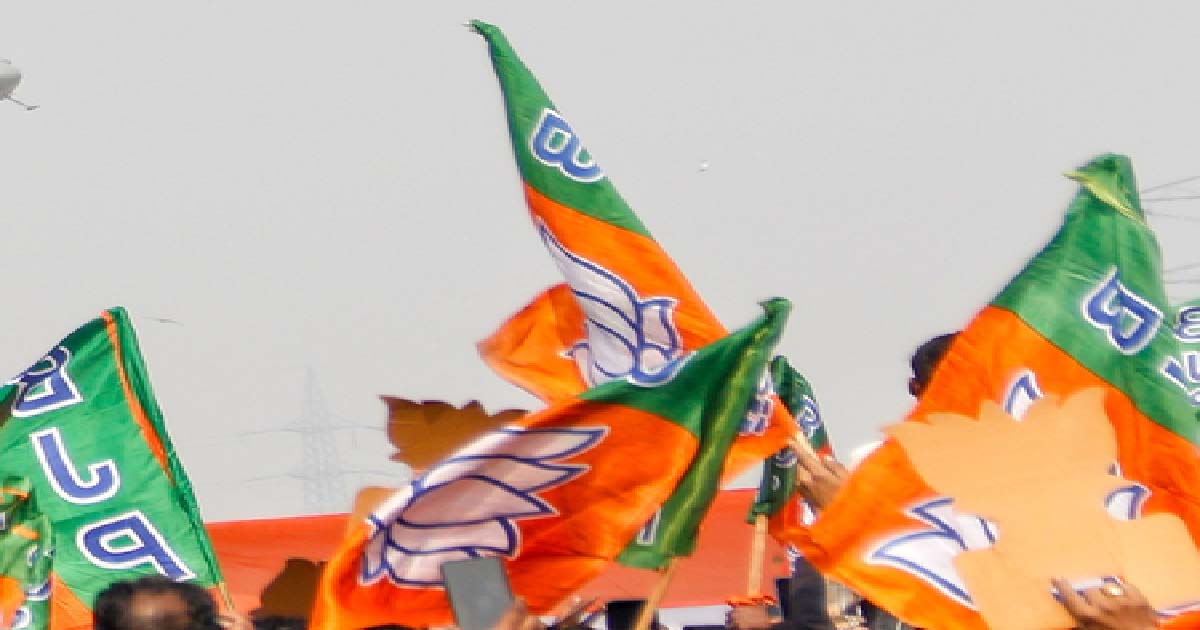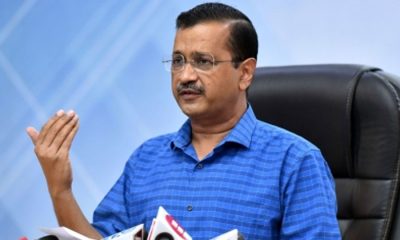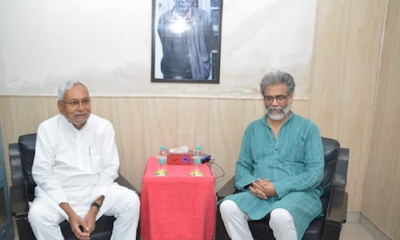National News
AAP emerging as single largest party in Punjab

Punjab is likely to witness a hung Assembly, with AAP emerging as the single largest party in the state in the 2022 state polls, as per the ABP-CVoter-IANS opinion poll.
The battle for the throne of Punjab is between INC and AAP. Erstwhile NDA composed of BJP and Shiromani Akali Dal is no more in contention for power in 2022.
Incumbent Chief Minister Captain Amarinder Singh is facing strong anti-incumbency. In the latest round of opinion poll conducted in the state, while 64.8% of the respondents said they were dissatisfied with the performance of sitting chief minister, only 12.6% of those interviewed stated that they were very much satisfied and 19.0 said they were satisfied to some extent with his performance.
A strong anti-incumbency sentiment is prevalent not only against the sitting Chief Minister but with the overall Congress government in the state as 60.8% of the respondents expressed strong dissatisfaction with the performance of state government.
Similarly, majority of the respondents – 51% expressed dissatisfaction with the sitting MLAs of their constituencies.
This anti-incumbency sentiment combined with non-ending feud between Chief Minister Amarinder Singh and PCC chief Navjyot Singh Sidhu has created an opening for the AAP to rise as the main challenger. As things stand today, while Congress is projected to win a 28.8% vote share in Punjab, AAP is projected to grab 35.1% votes, SAD is projected to secure 21.8% votes and BJP is projected to win 7.3 % vote share
Translated into seats there is a possibility of hung house in Punjab Assembly 2022. AAP could be the single largest party as the party is projected to grab 51 to 57 seats. Congress may finish a strong second by winning 38 to 46 seats, SADl is likely to grab 16 to 24 seats and BJP may notch 0 to 1 seats. The total strength of Punjab assembly is 117 seats.
The strong anti-incumbency against sitting Chief Minister Amarinder Singh is also reflected in the fact that only 17.9% of the respondents consider him as the most preferred choice for the post of chief minister.
The survey revealed that AAP does not have a credible face from Punjab, who can be projected as chief minister face of the party. While 21.6% of the respondents said that Delhi Chief Minister Arvind Kejriwal is their preferred choice to be the next chief minister of the state, only 16.1% consider Bhagwant Mann, AAP’s face in Punjab as the preferred choice for the top job in the state. 18.8% stated that Akali Dal leader Sukhbir Badal was their most preferred choice for the post of chief minister.
According to the survey data, price rise and farmers’ issues are key issues of concern for the electorate of the state.
33.5% of the respondents said that spiraling price rise was a major issue of concern, 28.6% of those interviewed during the survey stated that issues related to agriculture/farmers was their top concern.
The sample for the poll is 81006 in five states covering 690 assembly seats. This State Poll is part of the largest and definitive independent sample survey tracker series carried out in India over the last 22 years, conducted by independent international polling agency CVoter, a globally renowned name in the field of Socio-Economic research.
May 2009 onwards, the CVoter Tracker has been carried out each and every week, 52 waves in a calendar year, in 11 national languages, across all States in UTs in India, with a target sample size of 3000 samples each wave. The average response rate is 55%. Starting 1st January 2019, C Voter is carrying the tracker on DAILY basis, using the rollover sample of 7 days (last 6 days + today) for tracker analysis.
National News
All preparations fully completed for Bihar polls: DGP Vinay Kumar

Patna, Nov 5: A day before the first phase of voting for the Assembly elections, Bihar Director General of Police (DGP) Vinay Kumar on Wednesday said that all preparations for the upcoming polls have been completed to ensure the polls are conducted peacefully and smoothly across the state.
DGP Vinay Kumar said the state police and administration are fully committed to maintaining law and order during the election process. He also appealed to the youth of Bihar to strengthen democracy by actively exercising their right to vote.
Speaking to Media, DGP Vinay Kumar said, “All preparations for the elections have been completed to conduct the polls peacefully. I also want to urge the youth of Bihar to come forward and make democracy stronger by using their voting rights responsibly.”
The DGP warned that anyone found involved in creating violence or any kind of disturbance during the polling process would face strict legal action.
“If anyone is found involved in violence or undesirable activity, they will not be spared. FIRs are being registered against all such offenders because no one is above the law,” he told Media.
Kumar further urged young voters not to be misled by anti-social elements.
“I request the youth not to fall into the trap of those who want to disrupt peace. Strengthen democracy by voting. The administration stands firmly with the people. If anyone faces any problem while casting their vote, they can directly contact us. Our helpline numbers have been made public for this purpose,” he added.
When asked about the FIR filed against Union Minister Lalan Singh for allegedly violating the Model Code of Conduct, the DGP said, “The Model Code of Conduct is known to everyone. If anyone disobeys it, an FIR is filed against them. The entire police and administrative team are working to ensure its strict implementation.”
Highlighting the preventive measures taken by the police, Kumar said, “If anyone attempts to create an undesirable situation or engage in violence, they will be arrested under preventive detention laws and released only after signing a bond. This year alone, around two lakh people have been arrested under such preventive measures.”
He added that special attention has been given to ensuring adequate deployment of security forces.
“Earlier, 1,500 companies of security personnel were allotted for the two phases of the elections. In the past six to seven days, an additional 150 companies of police personnel have been deployed, mainly in the districts going to polls in the second phase. The Dial 112 emergency service will remain fully functional, and citizens facing any issues can reach out immediately. Our social media monitoring cells are also active to track and counter misinformation,” he said.
The DGP also revealed that the police have taken strong action against those involved in criminal activities related to the elections.
“Anyone involved in criminal acts that attempt to disrupt the election process will face a speedy trial. In the past 25 to 30 days, around 800 accused individuals have been arrested. We will ensure that their cases are prioritised and convictions are achieved within two months. The Election Commission of India has also directed that such cases be given top priority,” he noted.
Reiterating his appeal to voters, Kumar said, “I appeal to every voter in the state to come out and vote without fear. Bihar is the mother of democracy, and it is our responsibility to protect its dignity. The youth must play a leading role in maintaining peace and harmony. If anyone notices anti-social activities, they should inform the authorities immediately. Strict action will be taken against those trying to disturb peace or spread violence.”
He further added that a few incidents of disturbances had been recorded, and the CID was investigating them.
“Such anti-social elements are being identified through videography. After the election, they will be sent to jail. Those who misuse weapons will face strict punishment. No one will be spared if they think they can escape by indulging in such acts,” Kumar added.
The voting for the Bihar Assembly elections will be held in two phases — November 6 and November 11, and the counting is scheduled for November 14. After the Election Commission of India announced the schedule for the 243-member Assembly, the Model Code of Conduct is currently in force across the state. Polling will be conducted in 121 constituencies in the first phase and 122 constituencies in the second phase.
National News
Watson hails Gill as ‘ridiculously talented’ batter ahead of Gold Coast T20I

Gold Coast, Nov 5: Former batting great Shane Watson has praised India opener Shubman Gill for maintaining consistency in his batting and stated it won’t take him long to adapt across different formats. He described the opener as a ‘ridiculously talented’ batter with amazing technique.
While Gill remains a key figure across formats, his T20I performances since returning to the format in September 2025 reveal a worrying trend, as he has scored just 170 runs in ten innings at an average of 24.14 and a strike rate of 148.24.
In the ongoing Australia tour, he is struggling, having scored 37 not out, 5, and 15 in the first three games of the five-match series.
Speaking to reporters here on Wednesday, Watson reflected on how challenging it is for a modern team batter to go through the phase of frequently changing formats and said, “It definitely is a challenge and the more you do it, the better you get at really understanding the little adjustments that you have to make to your technique, to your game plan, your mindset around each format to be able to then get into the best version of you every time you have to make that adjustment.”
The fourth T20I will be a historic game, as it will be the first time India and Australia play at the Carrara Oval (formerly known as the People’s First Stadium) in Gold Coast.
Watson expressed excitement about this stadium hosting a major event and said, “It’s an amazing opportunity for the Gold Coast to be able to show off its incredible natural beauty. For the Indian team to be able to come here, for the Gold Coast to be able to get a game of this calibre, is something very special to the Gold Coast community. So I’m sure the players and the Indian fans who have made their way here will certainly enjoy the tournament.”
Crime
Cooperative scam allegations rock BJP in Kerala ahead of local body polls

Thiruvananthapuram, Nov 5: A spate of alleged cooperative society scams in the state capital has put the Bharatiya Janata Party (BJP) on the defensive, threatening to dent its image ahead of the upcoming local body elections.
The party, which has served as the principal opposition in the Thiruvananthapuram Corporation for the past two terms, now finds itself battling allegations of financial impropriety and internal discord.
The crisis deepened after the suicide of Anil Kumar, a sitting BJP councillor in the Corporation and president of a local cooperative society.
He reportedly took his own life following severe financial distress after the institution failed to return deposits.
His death has not only sparked emotional outrage within the party but also turned the spotlight on the functioning of a few BJP-linked cooperatives in the city.
Adding to the turbulence, M.S. Kumar, one of the party’s prominent faces in Thiruvananthapuram and a former state secretary, publicly alleged large-scale loan defaults by senior BJP leaders from another Society, of which he is a key office-bearer.
According to Kumar, loans worth over Rs one crore were taken by state- and district-level leaders and never repaid.
One senior leader allegedly owes Rs 40 lakh, while another has defaulted on Rs 35 lakh.
Kumar accused the party’s top brass, including state president Rajeev Chandrasekhar, of failing to act despite repeated complaints.
He has also threatened to release the names of all defaulters, claiming that a good number of those who failed to repay loans are BJP members.
His revelations, first reported by the CPI(M) party daily ‘Deshabhimani’, have created ripples within the BJP and given ammunition to the Left, which has accused the party of “moral and financial decay”.
The CPI(M) has demanded a detailed probe into the alleged misuse of cooperative institutions under political patronage.
With the BJP scrambling to contain the fallout, senior leaders are reportedly in talks with Kumar to withdraw his damaging Facebook post.
However, as the controversy widens, the cooperative scandals threaten to overshadow the party’s campaign and undermine its credibility in Kerala’s politically charged capital.
Meanwhile, in the Thiruvananthapuram Corporation, the CPI(M)’s State Education Minister V. Sivankutty has expressed confidence of a sweeping win, while the Congress-led UDF has already taken the early lead by announcing candidates in 64 of the 101 seats and launching its campaign.
Kumar’s allegations have left the BJP rattled, with damage-control efforts now underway.
-

 Crime3 years ago
Crime3 years agoClass 10 student jumps to death in Jaipur
-

 Maharashtra1 year ago
Maharashtra1 year agoMumbai Local Train Update: Central Railway’s New Timetable Comes Into Effect; Check Full List Of Revised Timings & Stations
-

 Maharashtra1 year ago
Maharashtra1 year agoMumbai To Go Toll-Free Tonight! Maharashtra Govt Announces Complete Toll Waiver For Light Motor Vehicles At All 5 Entry Points Of City
-

 Maharashtra1 year ago
Maharashtra1 year agoFalse photo of Imtiaz Jaleel’s rally, exposing the fooling conspiracy
-

 National News1 year ago
National News1 year agoMinistry of Railways rolls out Special Drive 4.0 with focus on digitisation, cleanliness, inclusiveness and grievance redressal
-

 Maharashtra12 months ago
Maharashtra12 months agoMaharashtra Elections 2024: Mumbai Metro & BEST Services Extended Till Midnight On Voting Day
-

 National News1 year ago
National News1 year agoJ&K: 4 Jawans Killed, 28 Injured After Bus Carrying BSF Personnel For Poll Duty Falls Into Gorge In Budgam; Terrifying Visuals Surface
-

 Crime1 year ago
Crime1 year agoBaba Siddique Murder: Mumbai Police Unable To Get Lawrence Bishnoi Custody Due To Home Ministry Order, Says Report


















